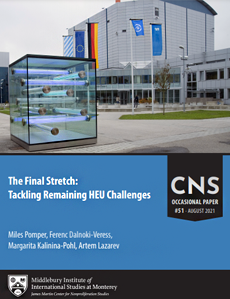August 17, 2021
Miles Pomper, Ferenc Dalnoki-Veress, Margarita Kalinina-Pohl, Artem Lazarev
 Minimizing civil commerce in highly enriched uranium (HEU) has been a longstanding goal of Global Partnership countries, as HEU represents a highly attractive target for terrorists and proliferators. HEU can be used to create the simplest nuclear explosive device, a so-called gun-type weapon. To make matters worse, because HEU is only weakly radioactive, it is relatively safe to handle and hard to detect. Even HEU waste is less radioactive than one might hope from a security-oriented standpoint. HEU’s primary civilian use is in research reactors, which carry out a range of functions from education and basic scientific research to producing medical isotopes and “doping” silicon for semiconductors. The international community has made significant progress during the last decades in converting such reactors from HEU to LEU fuels.
Minimizing civil commerce in highly enriched uranium (HEU) has been a longstanding goal of Global Partnership countries, as HEU represents a highly attractive target for terrorists and proliferators. HEU can be used to create the simplest nuclear explosive device, a so-called gun-type weapon. To make matters worse, because HEU is only weakly radioactive, it is relatively safe to handle and hard to detect. Even HEU waste is less radioactive than one might hope from a security-oriented standpoint. HEU’s primary civilian use is in research reactors, which carry out a range of functions from education and basic scientific research to producing medical isotopes and “doping” silicon for semiconductors. The international community has made significant progress during the last decades in converting such reactors from HEU to LEU fuels.
About the Authors
Miles Pomper
Miles Pomper is Senior Fellow in the Washington D.C. office of the James Martin Center for Nonproliferation Studies (CNS) of the Middlebury Institue of International Studies at Monterey and an expert in nuclear security. He is the author of numerous publications on HEU minimization and helped draft the HEU “gift basket” calling for the ultimate elimination of civilian HEU that Norway, Netherlands, and 20 other states announced at the 2016 Nuclear Security Summit. For six years, he served as chair of the Fissile Materials Working Group, a coalition of more than 80 organizations and individuals worldwide working to combat nuclear terrorism.
Ferenc Dalnoki-Veress
Ferenc Dalnoki-Veress is a scientist-in-residence at the James Martin Center for Nonproliferation Studies and Adjunct Professor at the Middlebury Institute for International Studies at Monterey. He holds an MSc and PhD in high energy physics from Carleton University, Canada, specializing in ultra-low radioactivity background detectors, and has professional experience in the field of astroparticle physics, primarily neutrino physics, where he has contributed to several major discoveries in the field. Dalnoki-Veress was a member of the Sudbury Neutrino Observatory Collaboration that won the 2015 Nobel Prize in physics and is a laureate along with his team of the 2016 Breakthrough Prize in Physics. He has contributed to more than forty articles in refereed and non-refereed journals. At the Institute, he focuses on the proliferation of fissile materials, nuclear spent fuel management, emerging technologies and verification of nuclear weapons. In March 2021 he published a co-authored book titled “Nuclear Choices for the Twenty-First Century: A Citizens Guide” published by MIT Press.
Margarita Kalinina-Pohl
Margarita Kalinina-Pohl is the Senior Program Manager/Research Associate at the James Martin Center (CNS) for Nonproliferation Studies at Middlebury Institute of International Studies (Monterey, California). During her 22-year career at CNS, Ms. Kalinina-Pohl held various positions at CNS, including managing CNS regional office in Almaty, Kazakhstan. Margarita’s current research interests include nuclear and radiological security. She is also engaged in several nonproliferation education and capacity building projects and initiatives aimed at promoting and empowering women in the nuclear field.
She authored and co-authored articles and reports on nuclear and radiological security, problems of uranium tailings in Central Asia and Soviet nuclear legacy.
Artem Lazarev
Artem Lazarev joined the VCDNP as a Research Associate in October 2017. Prior to that, he completed an internship at the Office of Legal Affairs of the International Atomic Energy Agency (IAEA) dealing with the legal aspects of nuclear safety, security and liability. Mr. Lazarev also worked as a lawyer at the European Court of Human Rights from 2012 to 2016 and has held several other legal posts in Russia and Spain.
Mr. Lazarev completed his PhD in International Law from the University Pompeu Fabra (UPF) in September 2017. His dissertation focused on the evolution of the legal aspects of the IAEA safeguards and their application to Iran. Previously he obtained a Master’s degree in Human Rights Law from the University of Strasbourg (2016), an Advanced Master’s degree in Legal Sciences at UPF (2011) and degrees in International Relations and in Law from Tomsk State University in Russia (2007 and 2008 respectively).
